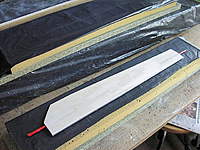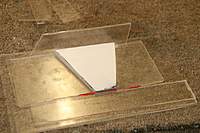|
|
|
|
Thread OP
|
Discussion
best fin/keel characteristics for IOM
A pretty green scratchbuilder speaking here. I am looking for the "best" fin possible for an IOM I am building (EMO). So, I am searching for the optimal parameters to use. The info out there is kind of confusing.
- is 6mm thickness the best compromise? Is there still a real advantage to struggle to go down 4 mm or less? - I cannot figure out what's the cross section profile used in the fins from commercial sources or in the best performing boats (eg. italiko, widget,..). I understood NACA does not perform as well as more recent profiles (eg. more drag). What are these "more recent profiles"? - Optimal planform/design? Top and bottom chords, lenght ? - taper ratio? 1:1 (parralel fin; same width at the root and the tip) or higher (trapezoidal)? - maximum flex we can tolerate? Or in other words, mimimal carbon (layers and g/sqm) needed? How do you guys proceed? Where can I look? Or does I make it overcomplex and it doesn't matter, any fin will make it? Help ! lesnicolas |
|
|
|
|
|
|
|
|
|
|
try these sites: http://www.onemetre.net/Design/Fillets/Fillets.htm
: http://www.onemetre.net/Design/FinArea/FinArea.htm : http://www.onemetre.net/Design/FinForce/FinForce.htm if all that doesn't confuse you I don't know what would 
|
|
|
|
|
|
|
|
|
I assume when you refer to NACA foils, you are thinking of the "four digit" symmetrical airfoils. These foils, numbered like 0007, 0010, etc, are suited for good lift/drag numbers at higher angles of attack. The "7" and "10" are the % thickness to chord ratios.
There are many other NACA foils that are symmetrical, with lower drag numbers at lower angles of attack. These are "six digit" airfoils. There are a couple of software programs that can generate line drawings of these foils based on your inputs of chord width and max thickness. They typically have their max thickness further back than the 30-33% of the four digit airfoils, and are sometimes referred to as laminar flow airfoils. Keep in mind that at a high angle of attack, they will be more draggy than four digit foils of the same thickness. See examples of the four digit, the 63 series and 64 series airfoils below. Note the finer entry and max thickness moving further back in the 63 and 63 foils. The four digit is more drag when at low angles of attack, like downwind, but less drag than the others when at high, >10* angles of attack. Always a tradeoff! Maybe a good solution is to use a four digit, thicker foil, on the rudder, with a 6-7% six digit foil on the fin. The rest is SOTP for me. I guess at the profile, what looks right! And it's much harder to get an accurate foil when the profile has curves on it, like an elliptical trailing edge. http://compufoil.com has a trial version you can play with, it just will not print the output, but only display it on screen. I have the paid version and use it for dinghy foils, and IOMs too. |
|
|
Last edited by hew565; Jan 09, 2010 at 12:38 PM.
Reason: Spelling and add screen shots
|
|
|
|
|
|
I have never seen anything on full keel boats, but since the EC12 is a one design class, you can't change the shape anyway.
As an anecdote, I talked to a major boat builder several years ago, and picked his brains a bit on this subject. His opinion on big boat keel shapes(displacement hulls like the Schock 24, J-30, etc) was that as long as the keel is symmetrical, the particular foil was not important. He thought the low Reynolds Numbers at which the boats operate, make the foil design insignificant. He thought this changes as you go to the faster, planning hulls like the Melges24's and even up to the VO70's, as the Reynold's Numbers get pretty high at the speeds these boats can go, and the foil design starts to play a role in the drag. |
|
|
|
|
|
|
|
Thread OP
|
Thanks for all your comments/suggestions.
It remains I have the feeling that keel design might strongly affect the IOM performances. I saw on Sailsetc website they have their own guy working on the foil profils. Might be one other best kept secret thing.  I did google a little bit. There are people optimizing profiles for applications in the low Reynolds number range. Here below a simulation I made in XFLR5 (free software). The simplistic 4-digit NACA (6% thickness) does not perform as well as some Selig profiles, with less lift and more drag at higher angles. The simulation was made for 60000 Re, varying the angle from 0 to 7°. Or all this is total bs.... 
|
|
|
Last edited by lesnicolas; Feb 02, 2010 at 03:27 PM.
|
|
|
|
|
|
Not BS, but I doubt I can absorb enough info to make more of an informed decision than just picking one that "looks good"
 Did you try comparing any of the six digit foils with the 4 and Selig? It would be interesting to see what angle of attack the drag would start shooting up with the six digit foils. Where did the XFLRS software come from? |
|
|
|
|
|
|
|
Thread OP
|
Thanks Hew for your feedback -
You can find XFLR5 without any problem like: http://www.softpedia.com/get/Others/...on/XFLR5.shtml There are many other free sofware out there to do the same kind of simulation, eg Xfoil and Javafoil. I guess we need to keep in mind these are just simulated data (drag, lift). I'll collect some 6-digit profiles and will have a try. I also mailed M. Selig, a university prof in aerodynamics-stuff, who is working in the low Reynolds field. I will keep you posted with all this if you have some interest. Remains I'd be curious to know if somebody already compared the different fins for their performance. I mean real-life testing. Cheerio, lesnicolas |
|
|
Last edited by lesnicolas; Feb 02, 2010 at 03:28 PM.
Reason: typo
|
|
|
|
|
|
I have experimented a bit with different foils and have not been able to tell them apart. Might just not be good enough to tell the difference. I have done NACA 0004, naca 0006, and some of the 63 foils. I have also run the numbers in Profili. See how a thin flat foil compares to a NACA0006 at low Re and you might be suprised. Will be doing a thin foil on my RG-65 instead of an air foil section. I also tried larger chords with thinner sections to see if raising the Re made more difference than the area gained. Built a 6" chord 4% fin to compare against the standard 6% with a 4" chord. Have not done enough testing on that one yet to rule it out. Upwind it should be better if you believe the programs.
I did see a difference in rudder performance by going to a thicker foil, I now use a NACA0009 on my star rudders since it offers much better performance when near stall than thinner rudders. Lets me use a smaller rudder so I get better rudder performance when overpressed. John |
|
|
|
|
|
|
|
Thread OP
|
Thanks John for your input -
I keep reading that the rudder should be thicker for better performances, more like 9%. Might be just me but what's the rationale behind? On the other hand, I did check a dozen rudders from various commercial sources. Almost all are at 6%, including those from Bantock. The only exception I found is the UR1 Ultralite from radiosailing shop (7.5%). Being new in the field, I have to admit all this looks more and more black magic to me. By the way, for the rudders you made, do you have some experience with carbon shaft ? lesnicolas |
|
|
|
|
|
|
|
|
Lesnicolas,
have you seen the build threads posted by Claudio at RCSailing.net? He details in the AC33 and the IACC120 Dual Build threads exactly how he makes his fins and rudders. Balsa / CF laminate with mounting bolts or rudder post. Several different designs he has tried. Excellent photos and step-by-step instructions. Below are some of his photos (there are many more on the threads. And if you read Italian there are links to more amazing stuff). Larry L. |
|
|
|
|
|
|
|
|
I am trying to figure a way to mold fins that will be able to be swapped between boats (with the same finbox). I have decided to construct a 4-part mold. Two sided "head" that will be bolted onto a two sided fin mold. THis will allow me to mold different fins, but all have the same "head" that I will mold finbox/mast steps from.
Today I laid up one side of both the head plug and a fin plug that I had made a while back. I used plexiglass as a parting board and as a flange to bolt the molds together when making the fin. I'll try to post photos as I go! ImagesView all Images in thread
|
|
|
|
|
|
||
|
|
Quote:
John |
|
|
|
||
|
|
|
|
|
Here are some photos of my rudders. the files for them are posted on the star 45 yahoo group or they can be bought already laser cut from www.stevensaero.com
|
|
|
|
|
|
|
|
|
Very interesting thread here. Does anyone have a link to a foil site(s) that would be good for a neophyte? Perhaps explain the differences between the different types of foils such as the Seligs, NACA's, and such? I'm only slightly conversant in this area, and I'm sure others would like enlightenment, too. This extends to sail foils, too. Thanks.
|
|
|
|
«
Previous Thread
|
Next Thread
»
| Thread Tools | |
| Similar Threads | |||||
| Category | Thread | Thread Starter | Forum | Replies | Last Post |
| Discussion | What's a good newbie waterplane? What characteristics am I looking for? | demuddy | Waterplanes | 5 | Dec 17, 2009 11:14 PM |
| Discussion | Keel Fin and Keel (fishing lead sinker) attachment? | FalconXman | Sailboats | 9 | Aug 26, 2009 07:14 AM |
| Discussion | Keel fin? | ballywho | Sailboats | 6 | Jun 21, 2007 10:51 AM |
| Discussion | Replacement bulb & keel fin for Voyager? | mrfirkin | Sailboats | 8 | Jun 19, 2007 11:39 PM |
| Help! | Keel Fin IOM | RhysPorter | Sailboats | 9 | Apr 13, 2007 05:23 PM |
















